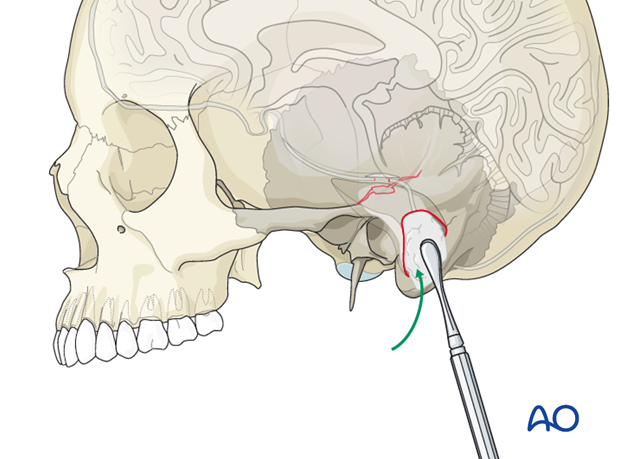Surgical management
1. Facial nerve decompression
Fractures of the temporal bone may result in injury to the facial nerve. In selected cases, it is believed that recovery of facial nerve function can be improved by decompressing the swollen nerve where it is encased circumferentially in bone; properly performed, decompression should decrease pressure on the blood supply to the nerve.
The nerve is surrounded by bone from its entry into the temporal bone via the internal auditory meatus until it exits the temporal bone via the stylomastoid foramen. Most injuries for which decompression would be considered occur between the geniculate ganglion and the stylomastoid foramen, so that decompression of the middle ear and mastoid portions of the ear should suffice.
In some cases, complete decompression will be necessary all the way back to the internal auditory meatus.
2. CSF leak: extracranial transmastoid approach
Most CSF leaks occur in the tegmen of the mastoid or of the middle ear. It is assumed that all best efforts to localize the site of the leak have been accomplished. The leak is surgically exposed and repaired using the surgeon’s preferred method.
Click here for a description of the transmastoid approach.
Some surgeons like to perform an underlay graft. This requires exposure of the torn dura and slipping the graft material between the dura and the surrounding bone, thereby sealing the leak. Many surgeons use fascia, perichondrium, or periosteum as graft material. Allograft material may also be used, and tissue glues may be used with or without the grafts.


3. CSF leak: Alternative: transcranial middle fossa approach
In cases of meningoencephalocele the state-of-the-art approach will be the middle fossa approach with careful reconstruction of the bony structures of the middle fossa floor. Sometimes this can be combined with a transmastoid approach.
Displaced fractures with a significant intracranial fragment are an indication for a middle fossa approach and reconstruction of the bony defects as well as ensuring a reliable dural repair.
Click here for a description of the lateral skull base approach.
4. Aftercare following management of temporal bone (lateral skull base) fractures
Some surgeons will use a lumbar drain to keep the CSF pressure low. If this is used great care must be exercised to ensure that excessive drainage of CSF does not occur inadvertently. Normally, not more than 240 ml/day should be drained. Stool softeners should be given to minimize straining. The head of the bed should be elevated.














